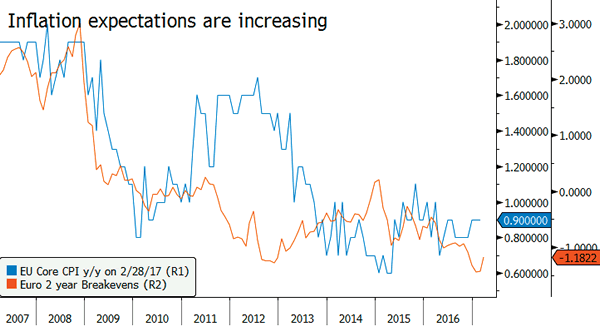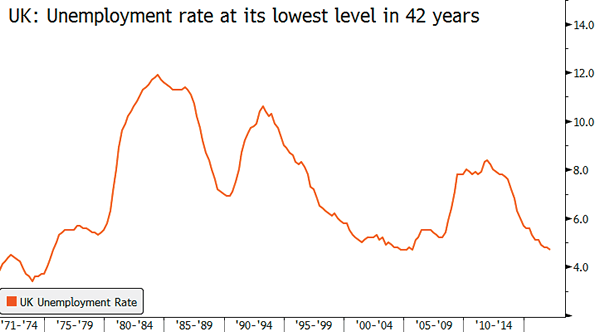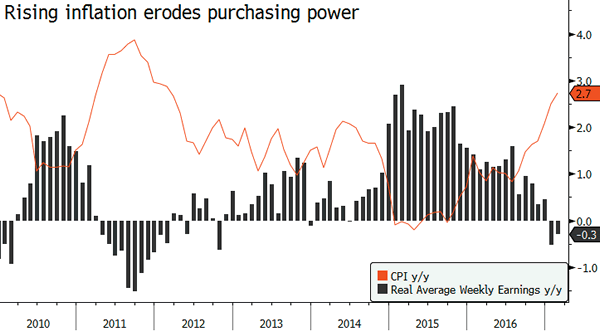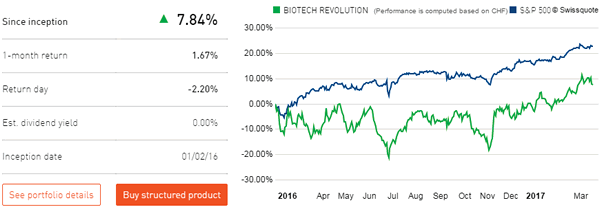Fed / ECB Policy Collision
At the start of the year the dominate thinking in FX markets was USD would outperform in the G10. With the Fed the only G10 central banks raising policy rates in 2017, yields differential would favor rotation in the greenback. However, with economic data in Europe rapidly improving, political risk dissipating and ECB members comments sounding hawkish the probability of ECB tightening has increase meaningfully. As stated in our Yearly Market Outlook the likelihood Fed and ECB policy converging in September forcing investors to shift their rate rotation strategy remains resilient.
Last weeks FOMC 25bp hike to 75-100bp indicates a reaction to rising inflation, strong confidence levels and robust optimism in financial markets. Yet lack of real improvement in data including core inflation and failure of real wages to improve forced a "dovish hike" statement (despite arguments to the contrary). The Fed fund rate median "dots "remained unchanged at three hikes in 2017 followed by three more in 2018. Yellens statement "we have plenty of time to see what happens" suggest a comfort level and not panic policy setting many had suggested. The sharp reaction in asset with US 10 year yields dropping 10bp, S&P jumping 1%, USD falling and rush into all things EM indicates scant worries of a steeper tightening cycle.
Barring any political upheaval (which is clearly a big "If") , by September, conditions should be correct for the ECB to begin indicating the removal of emergency support framework. At the ECB press conference Draghi indicated that risks of deflation had "largely disappeared" and stated that the ECB "no longer had a sense of urgency" is taking further action, clearly hawkish tone.
While in an interview with Handelsblatt ECB council member Nowotny suggested that process of policy normalization could see increase in the deposit rate ahead of ending bond purchases and prime rate. This is counter to the general expectations for ending QE before raising interest rate. It also opens the prospect of advance tightening. With a shallow Fed policy path and the ECB shifting toward less accommodation it’s hard to forecast sustained EURUSD weakness below 1.05. In addition, convergent tighter monetary policy around September should have impact of unbridled equity optimism.

Brexit: When Will Article 50 Be Triggered?
What a contradiction! The expected economic nightmare triggered by the Brexit vote has not materialised. Indeed, unemployment rate has reached its lowest level in 42 years at just 4.7%. It seems that at least for now, the UK economy is not the worse off from its decision to exit of the European Union. Nonetheless, it is worth noting that pressure on wages are almost non-existent. One explanation, the lack of job security (for example with the zero-hour contract) is showing the structural change of the labour market not only in the UK but globally in the western world. This definitely pushes unemployment rate to go lower.
Earlier last week, the Bank of England decided to keep its interest rates unchanged at 0.25%. It is clear that Brexit fears are helping the central bank as the pound remains weak. On top of that, we see European uncertainties growing in the medium term, in particular given the impact the French Elections outcome may have.
When looking more specifically at data, inflation is on the rise and we should see the BoE hinting to further tightening in the medium-term. The triggering of the article 50 looms and negotiations are likely to last longer than expected as trade agreements are paramount for the future UK competitiveness.
As Brexit proceedings drag on and fears of a hard Brexit continue to loom large, the pound continues to paint a very vivid picture of market worries. At present, UK Parliament remains split on PM May’s EU exit plans. The outcome however will be of little relevance as May will likely plough on and trigger Article 50 as planned. The question on everyone’s lips right now of course is whether the PM will cut the cord with no actual deal in place.
The pound has been feeling the heat from both the single currency and the greenback over the past couple of weeks on the back of renewed hard Brexit fears. We believe that there is a strong opportunity to reload bullish pound positions. The dragging out of these proceedings will be more damaging than the actual exit itself. Brexit will clearly not be the promised apocalyptic nightmare and will allow the UK breathing space to regain its competitive stance, free from constraint from Brussels.

Negative Real Wage Growth Threatens US Recovery
The US dollar had a tough week amid lacklustre economic data and a rather dovish Federal Reserve. The US economy created 235k private jobs in February, widely beating the median forecast of 200k, while the previous month’s reading was upwardly revised to 238k. All employment measures improved in February as the unemployment rate eased to 4.7% as participation climbed to 63%. The U-6 measure, commonly known as the underemployment rate, fell to 9.2% from 9.4% a month previous. So, after such a bullish report how come the Fed sound that dovish?
Well, there are a few explanations for this. Firstly, wage growth clearly failed to impress despite the solid pace of job creation. Average hourly earnings grew 0.2%m/m versus 0.3% expected. In addition, inflation pressures have intensified over the last few months as crude oil prices recovered – the consumer price index rose 2.7%y/y in February. Taken together, these developments pushed real wage growth in negative territory during the first two months of the year – average weekly earnings contracted -0.5%y/y and -0.3%y/y in January and February respectively – which will ultimately translates into weaker purchasing power for the common American in the longer run. This is the first time since December 2013 that the gauge has dipped below the neutral threshold. In fact, since the fourth quarter of 2015 real wage growth has started to decelerate. This negative trend could explain why the Fed was not in such a hurry to raise rates last year.
Over the coming months the Fed will find itself on the hot seat as core inflation pressure remains subdued and US consumer are suffering from weaker purchasing power. As a quick reminder consumer spending accounts for roughly 70% of the US GDP. Moreover, less disposable money for consumers means less price pressure, which translates into falling consumer prices, which ultimately means that the Fed will have to increase rates slowly if not taking a break during the process altogether.
It is not without reason that Janet Yellen stressed, during the press conference, that the Fed remains data-dependent and not interested in aggressive tightening. So far the Fed appears relatively confident, meaning that it is betting heavily on Trump’s economic programme.
All in all, in the short-term the market will stay focused on the political risk in Europe, which would help the dollar to hold ground against the single currency. The dollar’s medium-term outlook is heavily dependent on the results of the EU political elections; however, should the political chessboard stay unchanged in Europe, the USD will start to reverse gains.

BioTech Revolution
The pharmaceutical industry is going through a minor revolution. Biotechnology has a broad mandate, covering a wide range of processes for transforming living organisms for human purposes. However, this theme focuses on a new breed of companies that have joined the race to use modern technology to create healthcare products. These companies harness cellular and bio-molecular processes to develop technologies and products to fight disease. Exploding R&D costs have forced traditional pharma companies to look to smaller, more agile, technology-driven firms as the primary pipeline for innovation. With public and private investors and big pharma all expecting the next big breakthrough to come from this dynamic sector, valuations are on the rise.
We built this theme by filtering on firms with a market capitalization of over $1 billion and positive sales growth over the past two years, ensuring that they have sufficient cash flow to fund the next blockbuster.
BioTech Revolution theme can now be trading in an easy to execute Strategic Certificate.













